
+- Like Ra's Naughty Forum (https://www.likera.com/forum/mybb)
+-- Forum: Bondage (https://www.likera.com/forum/mybb/Forum-Bondage)
+--- Forum: Bondage General (https://www.likera.com/forum/mybb/Forum-Bondage-General)
+--- Thread: Bondage 101 Rope safety (/Thread-Bondage-101-Rope-safety)
Pages:
1
2
RE: Bondage 101 Rope safety - Like Ra - 13 Oct 2020
Source: https://www.youtube.com/watch?v=ROKfBGy6WDg
How to not to hit a nerve - SLL - 20 Sep 2021
Hello,
So this is some practical anatomy I am sharing with you in the hope that you will use it not to impinge any nerves during BD, if you aim for these for SM that is your own problem. I teach anatomy, so I know a little bit about the subject.
Any sustained nerve impingement can cause lasting injury. If there is numbness, there is trouble.
In the image below, 7 is the radial never. It runs up, through the arm pit and can be impinged by hanging the arm up and over a chair (for example, magenta arrow). This will result in numbness down the back of the forearm and hand as well as the first 3 or 4 fingers. 12 is the ulna nerve which over the medial epicondyle, unhumorously called the funny bone. Any structure across the medial and lateral epicondyle could impinge on the ulnar nerve. This will result in muscle weakness of the flexor muscles of the hand as well as numbness of the last 2 fingers and corresponding portion of the hand. You will also lose some thumb function.
Ideally, do not hang the arm over any solid object so that the radial nerve is impinged, and don’t put any strictures over the medial epicondyle of the humerus.
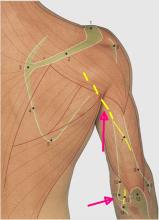
When considering the hands, note that the ulnar nerve (5) enters the hand on the pinky-finger side. If the hand is deviated in the direction of the magenta arrow, the nerve can be impinged against the hook of the hamate bone. This will result in numbness of the pinky-side of the hand and last 2 fingers. You will also lose some control of the thumb and grip strength as the ulnar nerve innervates the interosseous muscles needed to flex the fingers and adductor pollicis needed to hold something in our hand by pressing the thumb up against the fingers (look up Froment's sign). The median nerve, 6, can be impinged by flexing the hand back against the forearm (the blue arrow). How quickly the hand and first 3-4 fingers get numb will depend on the size of your carpal tunnel. Any impingement will cause inflammation which will cause swelling in the tunnel, so pain form function loss due to impingement could last for days.
To avoid both of these nerves it is best to ensure that the hand is kept straight relative to the forearm and does not deviate from that position.
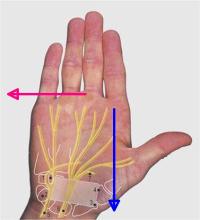
The radial nerve is shown in the picture (2) coming up from the arm and then over the distal head of the radius bone. It travels down the arm, together with the radial artery (1) under the brachioradialus muscle and is well protected. Both the artery and nerve can be impinged by any stricture put across the distal part of the forearm, especially at the head of the radius. The radial nerve supplies sensory function to the back of the hand and back of the first 3 to 4 fingers (but not the nailbeds which are innervated from the others side of the hand). Blood flow dominance varies from person to person, with some people having the ulnar artery supply most of the blood of the hand, and the radial in others. The ulnar artery is hard to occlude, but the radial isn’t. The dorsal part of the ulnar nerve come across to innervate the rear of the hand in front of the distal head of the ulnar bone and is unlikely to be impinged.
Any strictures should be positions so that they do not compress the artery or nerve, or have sufficient padding, so they can’t. Keeping the hand straight will also lower the chance of impinging the nerve.
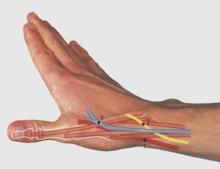
If you thought this was valuable, let me know, and I will take the time to discuss other parts of the body.
All images were taken from https://doctorlib.info/anatomy/surface-anatomy/7.html .
RE: Bondage 101 Rope safety - PurpleVibes - 20 Sep 2021
(20 Sep 2021, 16:50 )SLL Wrote: If you thought this was valuable, let me knowIt is valuable, I'm into numbness and self bondage so this information is very useful. 😁
RE: Bondage 101 Rope safety - SLL - 10 Nov 2021
Nerves of the Thigh, Leg and Foot
Once again, to be clear, I am sharing this information with the goal that you avoid these nerves and injuring yourself. If you choose to do otherwise that is on you.
The nerves running in the thigh are all deep and are not easy to compress. You have to sit down on the toilet a long time before you compress the sciatic nerve enough to cause paresthesia in the leg. In the sitting position the sciatic nerve is drawn more tort than when the leg is straight and is most at risk towards the knee where it splits (13 & 14 in the figure), so any ties across the lower thigh, above the knee, should be avoided.
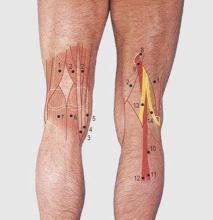
Lateral to the knee is the common fibula nerve (10 on the figure below). This nerve runs superficially for a short bit before diving deep between the fibula and tibia. At this point it is easily injured. Injury would result in both paresthesia as well a motor deficits, most notably foot-drop. You don’t want foot drop. The saphenous nerve is on the other side of the knee but is much deeper and harder to compress.
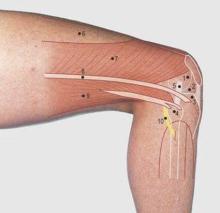
At the ankle, the deep and superficial fibula nerves are most at risk (at 11 and 10 on the figure). Compression of the deep fibular nerve results in ski-boot syndrome. Because there is a very superficial vascular bundle here any tie at this point will not only compress the nerve but also restrict blood flow to the foot and venous and lymph drainage. This means that any compression can cause intense pain that can endure for a long time after the tie is removed as it takes time for the swelling and inflammation to resolve.

RE: Bondage 101 Rope safety - SLL - 10 Nov 2021
Head & Neck
To be especially clear any damage to these nerves would be very serious, even fatal, and any purposeful attempt to compress them is just plain stupid. If you are dumb enough to misuse this information it is your own fault. You knew where not to exert pressure.
Most important below is 5, the phrenic nerve. It innervates the diaphragm and without it you can’t breath. It runs over the anterior scalene muscle which is hidden just behind the sternocleidomastoid muscle (not numbered below, but is over the structure labeled 6). Compression of this nerve is to be avoided.
3 is the brachial plexus. This is a network of nerves originating from spinal segments C5 to T1. This innervate your shoulder, arm and hands. They are quite fragile and normally protected by a lot of fat but any pressure deep into the space shown, just in front of the trapezius muscle, would be hellishly painful and possibly result in lasting damage to the nerves. Don’t apply pressure in that space.
Running with 6, in the carotid sheath, is the vagus nerve. This nerve regulates lung and heart function. If you irritate the nerve you can pass out or even die. Do not apply pressure over the jugular veins or carotid arteries. This can be fatal. The carotid sheath runs up behind the sternocleidomastoid up in the direction of the ear.
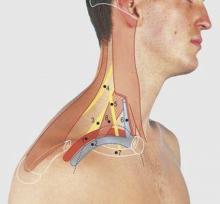
At the rear of neck, where it meets the skull is a large nerve, the greater occipital nerve (red arrow) which can be compressed between two neck muscles when the head is flexed forward. Compression of this nerve can cause neck pain as well as severe headaches, like migraines, that project to the forehead and temples because of a quick in the wiring of the nervous system. Keeping the head in a forward posture, where the neck is flexed forward but the end extended to look forward can cause pain just behind and below the ears due to muscle tension in the sternocleidomastoid muscle. This can also compress the lesser occipital (blue arrow) and great auricular nerves which, again, can manifest as migraine-like headaches to the temples and forehead.
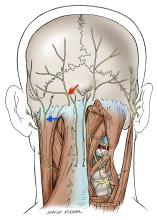
I hope you can use this information to enjoy bondage for longer without sever discomfort or damage to any nerves.
Surface anatomy images were mostly taken from https://doctorlib.info/anatomy/surface-anatomy/index.html